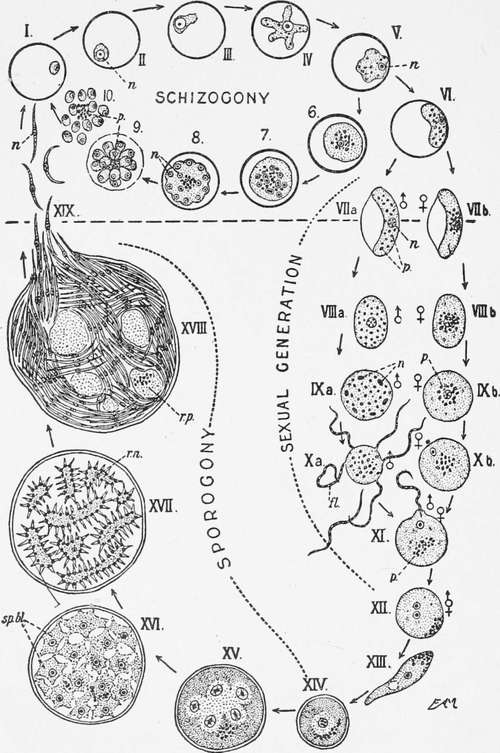The Mosquito-Malarial Cycle. Part 3
Description
This section is from the book "Malaria, Influenza And Dengue", by Julius Mennaberg and O. Leichtenstern. Also available from Amazon: Malaria, influenza and dengue.
The Mosquito-Malarial Cycle. Part 3
In the case of the malaria parasites there are also two cycles, the asexual and the sexual, or, to give them their synonyms, that of auto infection, schizogony, monogony, or endogenous cycle, on the one hand, and that of the new infection, sporogony, amphigony, or exogenous cycle, on the other. The stages are closely analogous to that of a Coccidian, with some slight differences:
(1) The young parasite or trophozoite in the blood cell grows up and becomes a schizont (sporulating body), which divides by schizogony into a number of spores or merozoites. These merozoites arranged around the central clump of pigment constitute the "daisy" or "roset" form. They become free in the blood by disintegration of the blood cell, and again attack other red cells, producing auto infection, and so the asexual cycle is completed.

Fig. 4.-Life history of a Malaria Parasite-Laverania Malaria (after Minchin).
I-V and 6-10, Cycle of schizogony, or fever cycle; VI, indifferent gametocyte; Vila male crescent; VII6, female crescent; Xa, emission of microgametes (flagella) by the male; XI, fertilization of female; XII, zygote; XIII, vermicule or ookinete; XIV, oocyst; XV and XVI, formation of sporoblasts; XVII, formation of sporozoites; XVIII, mature oocyst containing numerous sporozoites; XIX, free sporozoites. The dotted line represents the passage from the blood to the mosquito and in the reverse direction.
(2) At a certain period, however, the young parasites, merozoites, or sporozoites, instead of following this course, develop into sexual cells of two types-the microgametocyte and macrogametocyte, which can be recognized in the blood.
The next stage (in the mosquito's stomach) is the development of microgametes (or flagella) from the male cell, and the fertilization of the macrogamete. The product of the conjugation is here also termed a zygote. It has been also termed a copula and amphiont, and more appropriately, from its properties, a vermicide or ookinete. This becomes encysted and constitutes the oocyst. Within this develop sporoblasts, and these give rise, without the intervention of any spore stage, to sporozoites ("sickle bodies"). These eventually leave the mosquito during the act of "biting" and infect the fresh blood corpuscles of a new host, and so the sexual cycle is completed.
Lankester, commenting on the known facts of the developmental cycle, has pointed out that microgametes are true spermatozoa in form, appearance, and mode of development; "the production of the sporozoites by centrifugal proliferation and the production of a blastophore (residual segmentation mass) characterize them as truly male cells." In this respect the malarial parasite is peculiar. The fission products of the fertilized cell are not large cells, comparable in size and form to the female cells or macrogametes, but are in form and mode of development identical with male cells or microgametes, and hence when these cells infect a new host and develop into schiz onts, we have an instance of parthenogenesis by means of male elements (androcratic parthenogenesis), and not by female elements, as hitherto the only method known.
In the possession of a vermicule stage the malaria parasite comes nearer to the Gregarinidce than they do to the Coccidice, but they agree with the latter in the possession of a sexual cycle. The cycles of the malaria parasites may be expressed thus:
Sporozoite -> schizont X merozoite -> schizonts X merozoites -> gametocytes X n gametes } + = zygotes x m sporoblasts x mn sporozoites.
gametocytes ->gametes }
Before concluding our consideration of the systemic position and relationships of the Hemosporidia we may briefly enumerate the subdivisions of the Hemosporidia themselves, though at present, from lack of knowledge, and more especially of the cycles of development, the classification is only temporary.
Order Hemosporidia
Suborder. Genera.
1. Hemosporea. 1. Lankesterella. 2. Karyolysus. 3. Hemogregarina.
2. Acytosporea. 1. "Plasmodium." 2. Laverania. 3. Hemoproteus. 4. Halteridium(?). 5. Piroplasma. Unclassified Polychromophilus, Achromaticus, Cytameba, Dactylosoma, Kary ophagus, Hemapium, Haemamceba metchnikovi, etc.
Continue to:
Tags
mosquito, malaria, influenza, dengue, symptoms, outbreaks, diseases, hemoglobinuria, infections
